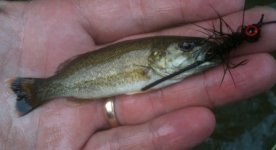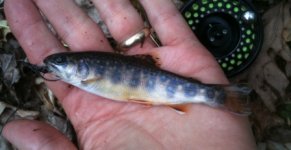You are using an out of date browser. It may not display this or other websites correctly.
You should upgrade or use an alternative browser.
You should upgrade or use an alternative browser.
Chaz
Active member
- Joined
- Sep 13, 2006
- Messages
- 8,454
Even at 1 inch long you can tell if a fish is a brookie or brown.
salvelinusfontinalis
Active member
- Joined
- Sep 9, 2006
- Messages
- 7,284
Brook trout without a doubt. It DOES have a white/black anal fin and I have never seen orange like that on a brown trout.
Unfortunately stocked ;-) haha
Unfortunately stocked ;-) haha
Stenonema
Active member
- Joined
- Jun 17, 2009
- Messages
- 466
It is easy to see how you could be confused. No shame in mis-identifying that one. Wild browns often have crimson and white edged fins. The variations in spot shading and patterns vary so much individually in trout even brook trout. One of the reasons I love catching them, they all look special and often unique in some way. This one does not have well pronounced spots of any kind but the faded orange spots give it away for me.
Luke
Member
- Joined
- May 18, 2010
- Messages
- 250
The pelvic fin coloring, anal fin coloring, lack of any black spots, and how far the mouth extends back toward the eye of the fish lead me to the conclusion that this is a Brook Trout.
Interesting to see the varied opinions on what should be somewhat simple ID
My opinion will probably be proven wrong as I seem to be in the minority.
Interesting to see the varied opinions on what should be somewhat simple ID
My opinion will probably be proven wrong as I seem to be in the minority.
Luke
Member
- Joined
- May 18, 2010
- Messages
- 250
I change my vote. Now I say that he is going to grow up to be a Tiger Trout!
JackM
Moderator
Staff member
- Joined
- Sep 9, 2006
- Messages
- 17,324
Obvious tiger trout.
JackM
Moderator
Staff member
- Joined
- Sep 9, 2006
- Messages
- 17,324
Dang!
dc410
Well-known member
I say it is a brookie. But, either way the thing that I often find amazing is the voracious appetite of some of the these very small fish in all species. My intention is not to side track the thread, it has been a lot of fun to follow, but what in the world was this fish thinking? :lol:
Attachments
Chaz
Active member
- Joined
- Sep 13, 2006
- Messages
- 8,454
Some browns don't have dark spots, especially when that small. brookies always have the dark back and light spots. No matter how small they also always have the red black and white lines on all fins. Browns never have red black and white on the pectoral fins.
Luke
Member
- Joined
- May 18, 2010
- Messages
- 250
Chaz,
I highly respect your opinion. However, look at Streamerguy's photo on left. I assume that you agree that his "Brook" is a actually a Brook Trout. If so, notice how the pectoral fins are lagging in any color development. The fish of the OP is on the right.

I highly respect your opinion. However, look at Streamerguy's photo on left. I assume that you agree that his "Brook" is a actually a Brook Trout. If so, notice how the pectoral fins are lagging in any color development. The fish of the OP is on the right.

dc410
Well-known member
L
lycoflyfisher
Well-known member
- Joined
- Apr 15, 2014
- Messages
- 1,358
Op is definitely brook trout, best way to tell especially on young fish is color of adipose fin. Brown trout have red adipose fin, especially clear on wild fish. Brook trout always have clear adipose fin. This is sure way that fisheries biologists use to I'd young of year trout during electrofishing.
Luke
Member
- Joined
- May 18, 2010
- Messages
- 250
lycoflyfisher wrote:
Brook trout always have clear adipose fin. This is sure way that fisheries biologists use to I'd young of year trout during electrofishing.
Very interesting. I always learn something new on this forum!
L
lycoflyfisher
Well-known member
- Joined
- Apr 15, 2014
- Messages
- 1,358
Comes from 3 summers of sampling headwater streams for unassesed waters initiative as an intern
F
Fishidiot
Active member
- Joined
- Sep 9, 2006
- Messages
- 9,960
It's a brook trout.
sarce
Well-known member
- Joined
- Feb 16, 2013
- Messages
- 1,504
Brook trout 100%. And not that he needs me defending him, but this guy knows his fish. Frankly I'm surprised that it even came up for debate, it looks just like any other brook trout...then again, this is the internet.
Didn't see anyone mention the marking on the dorsal fin. Browns don't have that.
Didn't see anyone mention the marking on the dorsal fin. Browns don't have that.
streamerguy
Well-known member
- Joined
- May 9, 2011
- Messages
- 1,457
lycoflyfisher wrote:
Op is definitely brook trout, best way to tell especially on young fish is color of adipose fin. Brown trout have red adipose fin, especially clear on wild fish. Brook trout always have clear adipose fin.
I was going to mention that........until I came across a small brown in my fish pic database with a very clear adipose.
PAFF is dangerous. You stare at a dink troot longer than any normal human being would and get brainwashed into thinking a brook is a brown lol
Great point about the dorsal sarce...
MKern
Active member
- Joined
- Sep 11, 2006
- Messages
- 3,822
My original thought was brown. However, without reading through the thread yet and just looking at the picture, I'm 99% sure it's a brookie.
Here's why: you can see lighter markings on a darker background on its back and the markings on the dorsal fin. And on the "main" spot on its side, it appears to to have the start of a blue halo around it.
Here's why: you can see lighter markings on a darker background on its back and the markings on the dorsal fin. And on the "main" spot on its side, it appears to to have the start of a blue halo around it.






